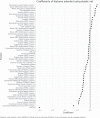Predicting student outcomes using digital logs of learning behaviors: Review, current standards, and suggestions for future work
- PMID: 36018483
- PMCID: PMC10556130
- DOI: 10.3758/s13428-022-01939-9
Predicting student outcomes using digital logs of learning behaviors: Review, current standards, and suggestions for future work
Abstract
Using traces of behaviors to predict outcomes is useful in varied contexts ranging from buyer behaviors to behaviors collected from smart-home devices. Increasingly, higher education systems have been using Learning Management System (LMS) digital data to capture and understand students' learning and well-being. Researchers in the social sciences are increasingly interested in the potential of using digital log data to predict outcomes and design interventions. Using LMS data for predicting the likelihood of students' success in for-credit college courses provides a useful example of how social scientists can use these techniques on a variety of data types. Here, we provide a primer on how LMS data can be feature-mapped and analyzed to accomplish these goals. We begin with a literature review summarizing current approaches to analyzing LMS data, then discuss ethical issues of privacy when using demographic data and equitable model building. In the second part of the paper, we provide an overview of popular machine learning algorithms and review analytic considerations such as feature generation, assessment of model performance, and sampling techniques. Finally, we conclude with an empirical example demonstrating the ability of LMS data to predict student success, summarizing important features and assessing model performance across different model specifications.
Keywords: Data privacy; Digital data; Equity; Learning management system; Machine learning.
© 2022. The Author(s).
Figures
References
-
- Baker, R.S., & Hawn, A. (2021). Algorithmic bias in education. Unpublished.
-
- Baker RS, Lindrum D, Lindrum MJ, Perkowski D. Analyzing early at-risk factors in higher education e-learning courses. Montreal: International Educational Data Mining Society; 2015.
-
- Barber, R., & Sharkey, M. (2012). Course correction: Using analytics to predict course success. In Proceedings of the 2nd international conference on learning analytics and knowledge (pp. 259–262).
-
- Bernacki, M.L. (2018). Examining the cyclical, loosely sequenced, and contingent features of self-regulated learning: Trace data and their analysis.
Publication types
MeSH terms
LinkOut - more resources
Full Text Sources



